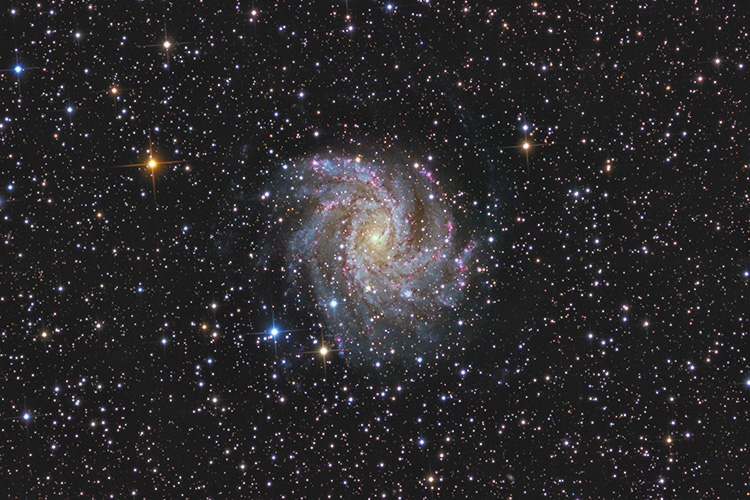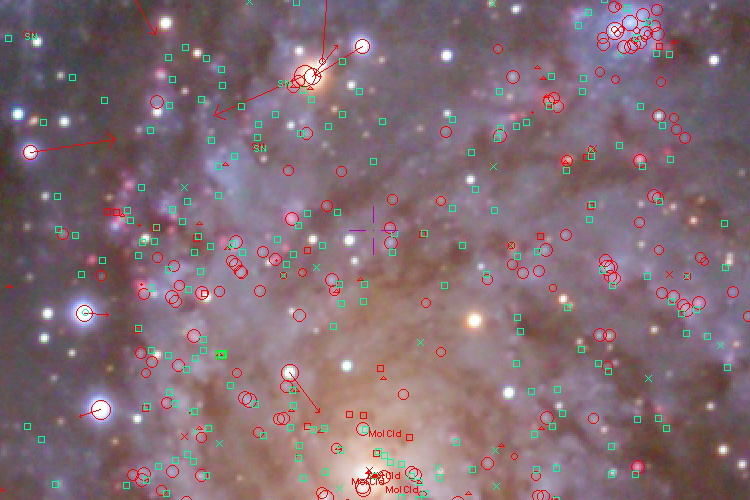|
|
Click
here for a highly stretched view,
showing foreground galactic clouds

Click the image for a full size view. (3000 x
2000 - 1.10 MB)

|
Modern technology has provided the means to identify many objects in
this relatively close galaxy. The red symbols are from the SIMBAD
data and the green from the NASA/IPAC Extragalactic Database
(NED).
Roll your mouse cursor over the image to turn the symbols on and
off.
The
red arrows indicate the apparent motion direction and speed for the
foreground stars.
|
Red Circles |
= star clusters |
|
Red Squares |
= super nova remnants |
|
Red Triangles |
= HI (21cm) sources |
|
Red X's |
= X-ray sources |
|
Green Squares |
= HII regions |
|
Green X's |
= X-ray sources |
|
Green Triangles |
= radio sources |
|
|
Instrument |
12.5" RCOS @
~f/9 (2880 mm fl) 0.64 arcsec / pixel. The Zoomify image scale
is 0.64 to 2.56 arcsec / pixel. |
|
Mount |
Paramount ME |
|
Camera |
SBIG STL-11000 w/ internal filter wheel, AstroDon Filters |
|
Acquisition Data |
8/10/2010 to 8/20/2010 Chino Valley, AZ... with CCDAutoPilot3
& CCDSoft. AOL guided |
|
Exposure |
Lum (no filter) 240 min (16 x 15 min, bin 1x1)
Ha
480 min (16 x 30 min, bin 1x1)
RGB
270 min ( 6 x 15 min each, bin 2x2) |
|
Software |
-
CCDSoft, CCDStack,
Photoshop CS w/ the Fits Liberator plugin, Noel Carboni's actions
and Russell Croman's GradientXTerminator.
-
eXcalibrator for (b-v), (v-r) color calibration, using 15 stars
from the NOMAD1 database. The lower image is corrected to
compensate for galactic extinction.
-
PixFix32 (pre-beta) to
repair hot/cold pixels and column defects.
-
CCDStack to calibrate,
register, normalize, data reject, combine the sub exposures and LRGB
color.
-
PhotoShop for LLRGB
plus Ha
combine &
on-linear stretching. The Ha data was added to the LLRGB's
red channel, using the lighten option for opacity.
|
|
Comment |
North is ~ to the top.
The image is rotated 40° clockwise.
NGC 6946 is located just 10 million light-years away, behind a veil
of foreground stars, in the constellation of Cepheus. During the
20th century, at least six supernovae, the death explosions of
massive stars, were discovered in NGC 6946. The most recent nova was
2004et. This high
frequency of supernovae is the reason for the Fireworks Galaxy
nickname.
Because NGC 6946 is at low galactic latitude, we view it through a
lot of dust and various nebulae. This causes the light to become
reddish, just as the Sun is red at sunset. This effect is called
Galactic Extinction. The top image was calibrated with foreground
stars and shows the galaxy with the effect of the extinction.
The bottom image was color corrected for galactic extinction and
shows NGC 6946 with its more intrinsic color. The color correction
factors, from the NASA/IPAC Extragalactic Database (NED), produce an
image that was obviously too blue. Assuming the Nasa data is
correct, sometimes it is not, then the upper image is not red
enough. Because of this discrepancy, the lower image was corrected
by balancing the histograms for each color channel, with the other
two. This generally works because the sum of the color, in a
nearby spiral galaxy, is basically white.
|
|